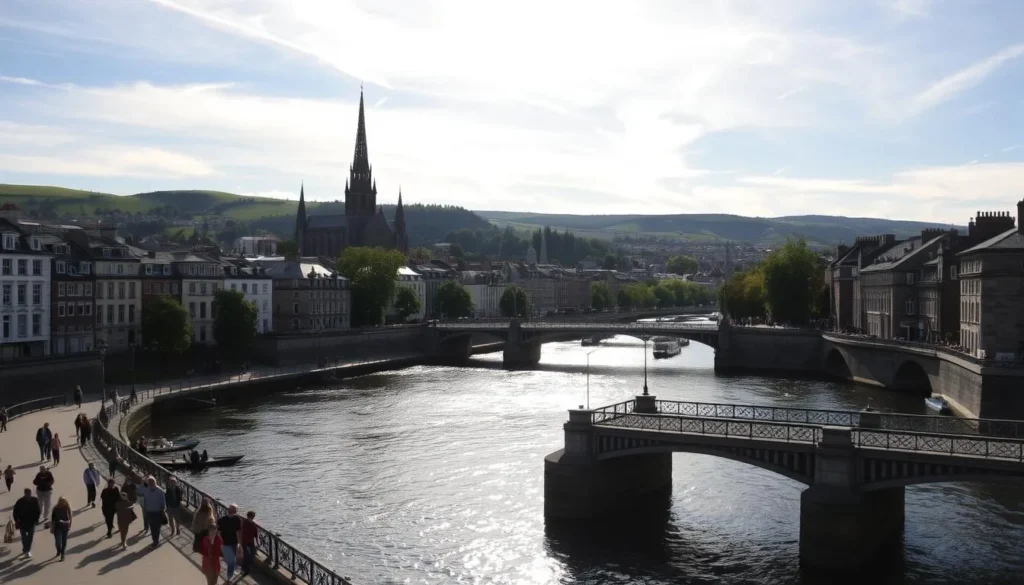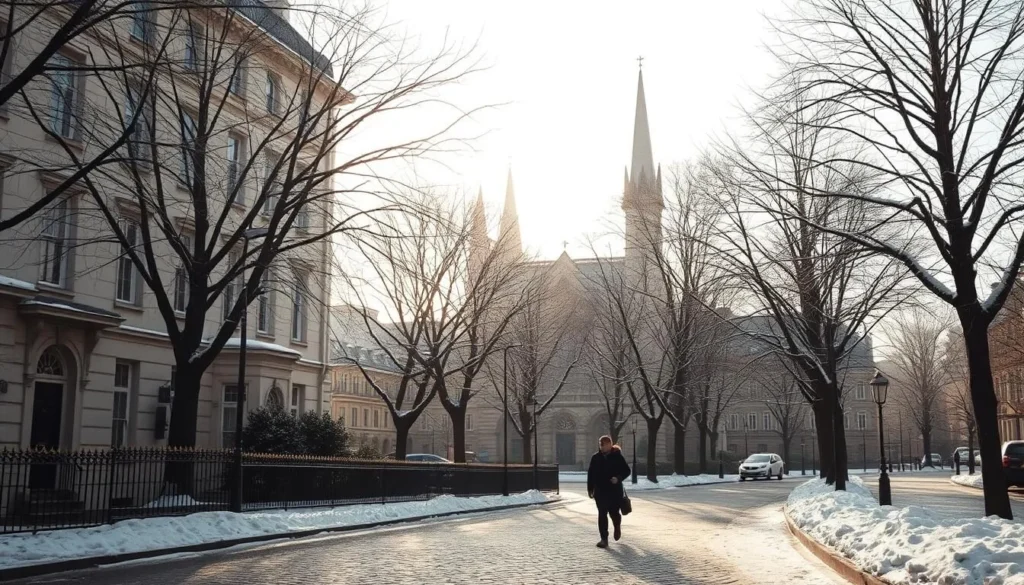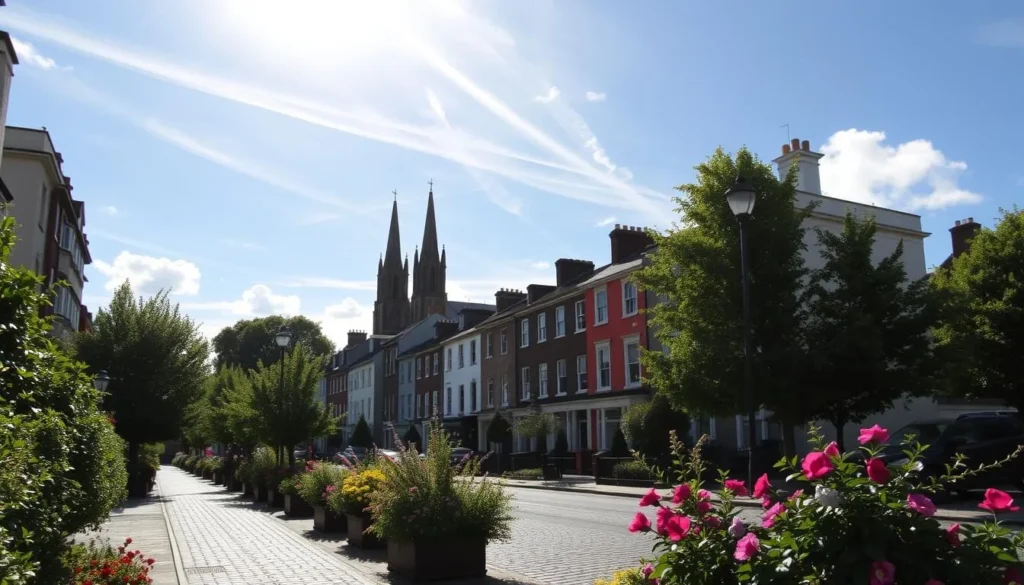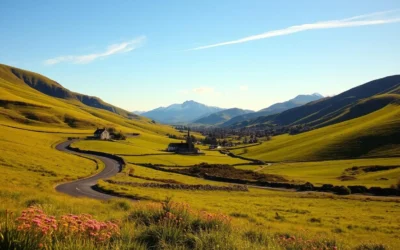Are you planning a trip to Dublin, but worried about the rain? You’re not alone. Many visitors put off their trip until summer, but the truth is, the best time to visit is often during the spring or fall.
Imagine strolling through Dublin’s historic streets in mild spring weather, or enjoying the city’s cozy pubs as the fall leaves change. With fewer crowds and more manageable temperatures, these seasons offer a unique experience.
Understanding Dublin’s climate is key to making the most of your trip. With the city’s infamous “four seasons in one day,” being prepared is crucial. This guide will help you navigate the best times to visit and make informed decisions about your travel plans.
Understanding Dublin’s Unique Weather Patterns
Dublin’s weather is as vibrant as the city itself, with a unique blend of maritime and temperate influences. This blend creates a fascinating mix of conditions that can be both mild and unpredictable.
The Temperate Irish Climate
Dublin’s temperate maritime climate means that the city experiences mild conditions throughout the year. Temperatures rarely drop below freezing in winter or exceed 70°F (21°C) in summer. The Gulf Stream plays a significant role in shaping Ireland’s climate, bringing milder conditions than other European destinations at similar latitudes. As a result, Dublin’s average temperatures remain relatively moderate year-round, with January being the coldest month at 41°F (5°C) and July the warmest at 60°F (15.5°C).
| Month | Average Temperature (°F) | Average Rainfall (mm) |
|---|---|---|
| January | 41 | 70 |
| July | 60 | 60 |
Four Seasons in One Day: Dublin’s Weather Unpredictability
You’ll quickly learn that Dublin’s weather is famously changeable – locals often joke about experiencing “four seasons in one day.” This unpredictability is due in part to the city’s coastal location, with sea breezes often bringing sudden changes in conditions. To make the most of your trip, it’s essential to be prepared for rain, as precipitation is possible any day of the year. Spring in Dublin brings gradually warming temperatures and blooming landscapes, though the weather remains variable with occasional rain showers.
Understanding Dublin’s seasonal patterns will help you pack appropriately and plan activities that maximize your enjoyment regardless of the weather. Whether you’re visiting in the spring, summer, autumn, or winter, being prepared for the local weather conditions will ensure a more enjoyable trip.
Dublin’s Weather by Season: What to Expect
As you plan your visit to Dublin, it’s vital to grasp the city’s seasonal weather changes to make the most of your trip. Dublin’s climate is temperate, but it experiences significant variations throughout the year, making each season unique.
Spring in Dublin (March-May)
Spring brings gradually warming temperatures, ranging from 46°F to 54°F (8°C to 12°C), along with increasing daylight hours and blooming landscapes across the city’s parks. You’ll enjoy fewer crowds and the beauty of Dublin’s gardens in bloom.
Summer in Dublin (June-August)
Summer offers the warmest weather, with average temperatures between 59°F and 68°F (15°C to 20°C), ideal for outdoor activities. July and August are the sunniest months, but be prepared for occasional rain showers. The long days, sometimes up to 17 hours, allow for extended sightseeing.

Autumn in Dublin (September-November)
Autumn features cooling temperatures, from 56°F down to 45°F (13°C to 7°C), with beautiful fall colors in Phoenix Park and other green spaces. This season is perfect for enjoying cultural events and the rich colors of the changing foliage.
Winter in Dublin (December-February)
Winter brings cooler temperatures, averaging 41°F to 44°F (5°C to 7°C), with shorter days and increased rainfall. While snow is rare, the festive decorations and cozy pub atmospheres make it a charming time to visit.
| Season | Average Temperatures | Daylight Hours | Rainfall |
|---|---|---|---|
| Spring (Mar-May) | 46°F – 54°F (8°C – 12°C) | Increasing | Moderate |
| Summer (Jun-Aug) | 59°F – 68°F (15°C – 20°C) | Up to 17 hours | Occasional showers |
| Autumn (Sep-Nov) | 45°F – 56°F (7°C – 13°C) | Decreasing | Moderate to High |
| Winter (Dec-Feb) | 41°F – 44°F (5°C – 7°C) | 7-8 hours | High |
Each season in Dublin has its unique charm and advantages. Understanding these seasonal variations will help you prepare and make the most of your visit, regardless of when you choose to go.
Dublin, Ireland: Best Months for a Weather-Savvy Trip
If you’re looking for the ideal time to visit Dublin, you’ll want to consider the months that offer the best balance of weather and tourist activity. Planning your trip during the right season can make a significant difference in your overall experience.
April and May: The Spring Sweet Spot
April and May represent Dublin’s spring sweet spot, offering mild temperatures ranging from 50-59°F (10-15°C) and extended daylight hours. During these months, you’ll encounter significantly fewer crowds than in the summer months, making it an ideal time to explore the city’s attractions. You’ll also appreciate the value of traveling during these shoulder season months, with lower flight prices and hotel rates compared to the peak summer period.
Spring in Dublin brings blooming gardens and parks, with daffodils and cherry blossoms creating picturesque settings for your exploration of the city. Some popular attractions to visit during this time include:
- The Botanic Gardens
- Phoenix Park
- St. Stephen’s Green
| Month | Average Temperature (°F) | Average Rainfall (inches) |
|---|---|---|
| April | 50 | 2.1 |
| May | 54 | 2.5 |
September and October: The Autumn Alternative
September and October provide an excellent autumn alternative for your Dublin trip, with pleasant temperatures and beautiful fall colors. The post-summer crowd reduction makes these months particularly appealing. You’ll find that hotel availability improves dramatically during these shoulder months, giving you more options and better rates for accommodations.
Both spring and autumn offer the perfect balance of reasonable weather conditions and manageable tourist numbers, allowing for a more authentic Dublin experience. Planning your trip during these times means you’ll have shorter lines at popular attractions like the Book of Kells, Guinness Storehouse, and Dublin Castle.

By choosing to visit Dublin during these optimal months, you’ll be able to enjoy the city’s outdoor attractions comfortably while still experiencing the vibrant cultural scene inside museums, theaters, and pubs if the weather turns inclement.
Summer in Dublin: Pros and Cons of Peak Season
The summer season in Dublin is a double-edged sword, offering pleasant weather but also higher prices and longer lines at popular attractions. As you plan your trip, it’s essential to weigh these factors to make the most of your visit.
The Warmest Weather
Summer in Dublin, spanning from June to August, brings the warmest weather of the year, with temperatures ranging from 59°F to 68°F (15°C to 20°C). This period provides ideal conditions for exploring the city’s outdoor attractions, such as parks and coastal areas. You’ll also enjoy extended daylight, with sunlight lasting until nearly 10 pm in June and July, giving you plenty of time to explore Dublin’s vibrant atmosphere.

Dealing with Summer Crowds and Higher Prices
While the summer months attract the largest crowds to Dublin, resulting in longer lines at popular attractions like the Guinness Storehouse and Trinity College, you can mitigate this by planning ahead. Be prepared for significantly higher prices during this peak season, with hotel rates often 30-50% higher than during shoulder seasons. Booking accommodations and popular attractions in advance can help minimize the impact.
Summer Festivals and Events
The peak season brings vibrant energy to the city with numerous summer festivals and events, including Bloomsday celebrations on June 16, the Dublin Horse Show in August, and various music festivals throughout the season. These events add to the city’s charm and provide a unique experience for visitors. With so much happening during the summer months, you’ll find plenty of opportunities to engage with the local culture.
Winter in Dublin: The Off-Season Experience
Dublin in winter is a hidden gem, offering a serene and peaceful experience for travelers. While it’s one of the coldest and wettest times of the year, the city’s charm is still palpable, especially during the Christmas and New Year celebrations.
Christmas and New Year in Dublin
The Christmas season transforms Dublin into a magical destination, with beautiful light displays along Grafton Street, Christmas markets at Dublin Castle, and special holiday concerts throughout the city. You can enjoy the festive atmosphere, explore the city’s indoor attractions, and experience the local culture.
January and February: The Budget-Friendly Months
After the holiday buzz, January and February are the quietest months, making them ideal for budget-conscious travelers. Hotel rates are often 50-60% lower than summer prices, and flights are significantly discounted. You can enjoy traditional Irish music sessions in pubs, explore museums and galleries, and experience the authentic Dublin without the crowds.
| Month | Average Temperature (°F) | Daylight Hours |
|---|---|---|
| December | 45 | 7-8 |
| January | 41 | 7-8 |
| February | 42 | 9-10 |

Month-by-Month Weather Guide to Dublin
To make the most of your trip to Dublin, you need to understand the city’s month-by-month weather guide. Dublin’s climate is known for being temperate, but it can be quite unpredictable. Here’s a breakdown of what to expect throughout the year.
January through March: Winter into Spring
January is one of the coldest months in Dublin, with average temperatures around 5.5°C (41.9°F). As winter slowly starts to fade, February remains chilly but begins to show signs of spring. By March, the city is buzzing with excitement for St. Patrick’s Day on the 17th, and the weather starts to warm up slightly.
Average Temperatures: January – 5.5°C (41.9°F), February – 6°C (42.8°F), March – 8°C (46.4°F)
April through June: Spring into Summer
April is a great time to visit Dublin as the spring weather brings mild temperatures, making it ideal for exploring the city. May continues this trend, offering a perfect balance of warmth and pre-summer tranquility. By June, the city is filled with young people from around Europe attending English language classes, and the atmosphere is lively.
Average Temperatures: April – 10°C (50°F), May – 12°C (53.6°F), June – 15°C (59°F)
July through September: Summer into Autumn
The summer months of July through September are the warmest in Dublin, with average temperatures ranging from 15°C to 18°C (59°F to 64.4°F). These months are ideal for exploring the city’s outdoor attractions and coastline. September can still feel like summer, with mild weather averaging 13.2°C (55.8°F).
| Month | Average Temperature (°C) | Average Temperature (°F) | Rainfall (mm) |
|---|---|---|---|
| January | 5.5 | 41.9 | 75-100 |
| April | 10 | 50 | 50-75 |
| July | 15-18 | 59-64.4 | 50-75 |

Dublin’s Rainiest Months and How to Prepare
Understanding Dublin’s rainfall patterns is crucial for a well-prepared trip. Dublin’s weather is known for being unpredictable, and being prepared for the rain can make a significant difference in your travel experience.
October through December: The Wettest Period
The last quarter of the year is the wettest in Dublin, with October, November, and December averaging over 120mm (4.7 inches) of rainfall. These months typically experience 15-22 rainy days per month. To prepare, pack essential items like a quality waterproof jacket, water-resistant footwear, and a sturdy umbrella. Even during the wettest months, rain usually comes in showers rather than all-day downpours, allowing for strategic sightseeing.
- Average rainfall: over 120mm (4.7 inches) per month
- Typical rainy days: 15-22 days per month
- Temperature range: 45-56°F (7-13°C)
Rainy Day Activities in Dublin
Dublin offers numerous excellent rainy day activities. You can visit world-class museums like the National Gallery and EPIC Emigration Museum, explore historic libraries, enjoy cozy pubs, or shop in covered areas like the Georges Street Arcade. Many popular attractions, including the Guinness Storehouse, Trinity College Library, and Kilmainham Gaol, are primarily indoor experiences, making them perfect for rainy days.

- Visit museums and historic libraries
- Explore indoor shopping areas
- Enjoy Dublin’s cozy pubs
Planning Around Dublin’s Cultural Calendar
As you plan your trip to Dublin, consider the city’s vibrant cultural calendar. Dublin hosts a wide range of festivals and events throughout the year, making it a great destination for culture lovers.
St. Patrick’s Festival
The St. Patrick’s Festival transforms Dublin each March, extending beyond St. Patrick’s Day to a five-day celebration featuring parades, concerts, and cultural events. You’ll need to book accommodations months in advance, as this is one of Dublin’s busiest periods.
Bloomsday
Bloomsday, on June 16th, offers a unique cultural experience, with literary enthusiasts following Leopold Bloom’s route through the city as described in James Joyce’s “Ulysses.”
Year-Round Cultural Events
Dublin’s cultural calendar is packed with year-round attractions, including the Dublin Theatre Festival, the Bram Stoker Festival, and traditional Irish music sessions in pubs like O’Donoghue’s and The Cobblestone. Many events take place indoors, making them perfect for any weather conditions.

With numerous music festivals, including the Longitude Festival in July, and various cultural events, you’ll find plenty to enjoy in Dublin, regardless of the season. By planning your visit around these events, you can experience the best of what the city has to offer.
Packing Essentials for Dublin’s Changeable Weather
Packing for Dublin requires a thoughtful approach due to the city’s temperate yet unpredictable climate. You’ll need to be prepared for various weather conditions, regardless of the time of year you visit. Layering is key as temperatures can fluctuate significantly even within a single day.
When you’re planning your trip, consider the activities you’ll be doing and the city’s compact nature, which means you’ll likely be walking extensively or using public transportation. This will help you decide on the essentials to pack.
All-Season Packing List
Your all-season packing list for Dublin should include versatile items like lightweight merino wool layers, a waterproof outer shell, comfortable walking shoes, and quick-dry clothing. These items will help you navigate the city’s changeable weather. You’ll also find that waterproof gear is essential year-round.
- A quality rain jacket
- Water-resistant footwear
- A compact umbrella
Season-Specific Items
While there are all-season essentials, certain items are season-specific. For summer, pack a light jacket and long pants for cooler evenings. In winter, focus on warmth with a heavier waterproof coat, gloves, a scarf, and waterproof boots. Spring and autumn visitors should prioritize a flexible wardrobe that can adapt to rapidly changing conditions.
| Season | Essential Items |
|---|---|
| Summer | Light jacket, long pants, breathable clothing |
| Winter | Heavier waterproof coat, gloves, scarf, waterproof boots |
| Spring/Autumn | Flexible layers, waterproof gear, comfortable shoes |
Accommodation and Transportation Tips by Season

To make the most of your visit to Dublin, understanding the seasonal variations in accommodation and transportation is crucial. Dublin’s weather and tourist season significantly impact your travel plans.
Finding the Best Hotel Deals
Hotel prices in Dublin fluctuate dramatically by season. You’ll find the best deals during the winter months (November-February), excluding the Christmas/New Year period, when hotels offer significant discounts. In contrast, peak summer rates (June-August) are often 40-60% higher than winter rates. Booking in advance is essential during peak season, especially around major events and music festivals.
Getting Around Dublin in Different Weather Conditions
Dublin’s transportation system operates efficiently year-round. The Luas tram, DART train, and bus network provide reliable service regardless of the weather. During good weather, walking is an excellent option in the compact city center. In contrast, the public transportation network offers convenient alternatives during rainfall or colder temperatures. Transportation options expand during summer, with additional hop-on-hop-off bus tours and bike rentals available.
Conclusion: Making the Most of Dublin’s Weather
Whether you’re visiting in summer or winter, Dublin’s charm persists through all seasons, offering a distinct experience. By understanding the city’s weather patterns and planning accordingly, you can maximize your enjoyment of this remarkable Irish capital.
With proper planning and realistic expectations, you can enjoy Dublin regardless of when you choose to visit. The best time to visit depends on your preferences – warmer weather, fewer crowds, or specific festivals.
The above is subject to change.
Check back often to TRAVEL.COM for the latest travel tips and deals.






